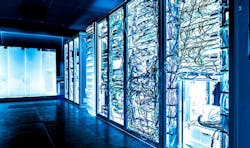AI's Growing Water Demand and the Need for Efficiency
VISTA, CA — The rapid expansion of artificial intelligence (AI) comes with a hidden environmental cost: enormous water consumption.
According to Investopedia, global AI demand is projected to consume between 1.1 and 1.7 trillion gallons of freshwater annually by 2027, equivalent to thirty-four billion gallons of water per week.
Where AI Uses Water
Training AI Systems
A University of California study, found that training an AI system for one language requires up to 185,000 gallons of water. To put this in perspective, that's enough water to manufacture 370 cars or fill three swimming pools.
Data Center Cooling
Phoenix, Arizona hosts numerous data centers that harness solar energy for electricity, at a cost of approximately 170 million gallons of water daily, straining the city's already limited water supply.
Microchip Production
Manufacturing a single AI microchip can consume up to 2,200 gallons of ultra pure water (due to repeated washing to remove contaminants). Since large AI systems operate on clusters of servers containing thousands of microchips, the cumulative water demand is substantial.
Energy Generation
AI data centers are expected to increase electricity demand by 16%by 2030. This surge amplifies water needs because generating this electricity requires significant amounts of water for cooling thermal power plants and nuclear facilities.
Environmental Impact
AI's water demand worsens global water scarcity and pressures local ecosystems. As AI technology becomes more prevalent, addressing water consumption becomes increasingly critical.
Fortunately, several innovative water-saving technologies are emerging to tackle this challenge:
- Air-based cooling systems that reduce reliance on water for data center temperature control
- Closed-loop water recycling, which enables the reuse of cooling water
- Native landscaping around AI facilities requires minimal irrigation
- Water-efficient fixtures such as waterless urinals are commonplace in AI data centers
These solutions are often recommended by AI systems themselves to help reduce the industry's water footprint.
The Path Forward
"AI is here to stay," says Klaus Reichardt, CEO and Founder of Waterless Co., Inc. "But we need responsible AI development that aligns technological progress with responsible, sustainable water use. That's imperative."
Reichardt adds that “balancing AI's benefits with environmental responsibility, ensures that advancement of this technology doesn't come at the expense of our planet's most precious resource.”
